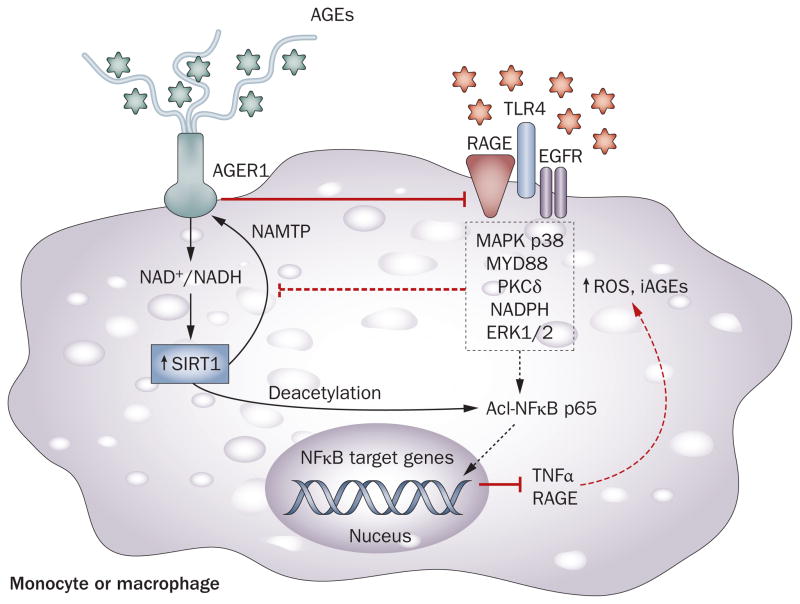Figure 2.
Synergism between AGER1 and SIRT1. Innate host defense cells, monocytes and macrophages normally bind, endocytose and degrade AGEs via the cell-surface AGER1 (also known as DDOST), the levels of which normally correlate inversely with intracellular levels of AGEs. Prolonged supply of external AGEs, however, depletes AGER1. Ensuing surplus ROS promotes inflammation via RAGE, TLR4, EGFR and other receptors regulating the activities of NFκB, AP-1, FOXO3 and other factors, via numerous pathways. These increase AGEs, ROS and inflammatory mediators, including RAGE and its ligands. AGEs, acting via ROS, are potent suppressors of NAD+, partly by reducing NAMPT and SIRT1 levels. Decreased SIRT1 levels promote NFκB p65 hyperacetylation and enhanced transcription of inflammatory genes consistent with an M1 macrophage profile. For instance, TNF induces an overlapping set of target genes, which contributes to insulin resistance. AGER1, by blocking AGEs, controls many of these effects. The protective effects of AGER1 may stem from its long extracellular tail with high-affinity AGE-binding, which competitively interferes with AGE–cell-surface interactions leading to ROS. This property may constitute the essence of the positive synergism between AGER1 and SIRT1. Though suppressed in humans and animals with chronic diabetes mellitus, monocyte/macrophage AGER1 and SIRT1 levels can be restored to normal following AGE restriction. Abbreviations: AGE, advanced glycation endproduct; AGER1, AGE receptor 1; EGFR, epidermal growth factor receptor; ERK1/2, extracellular signal-regulated kinase 1/2; FOXO3, forkhead box protein O3; MAPK, mitogen-activated protein kinase; MYD88, myeloid differentiation primary response protein MyD88; NAMPT, nicotinamide phosphoribosyltransferase; NFκB, nuclear factor κB; PKCδ, protein kinase C δ type; RAGE, receptor for advanced glycosylation endproducts; ROS, reactive oxygen species; SIRT1, NAD-dependent deacetylase sirtuin-1; TLR4, toll-like receptor 4; TNF, tumor necrosis factor.

